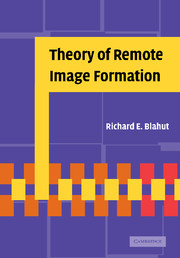Book contents
- Frontmatter
- Contents
- Preface
- Acknowledgements
- 1 Introduction
- 2 Signals in one dimension
- 3 Signals in two dimensions
- 4 Optical imaging systems
- 5 Antenna systems
- 6 The ambiguity function
- 7 Radar imaging systems
- 8 Diffraction imaging systems
- 9 Construction and reconstruction of images
- 10 Tomography
- 11 Likelihood and information methods
- 12 Radar search systems
- 13 Passive and baseband surveillance systems
- 14 Data combination and tracking
- 15 Phase noise and phase distortion
- References
- Index
11 - Likelihood and information methods
Published online by Cambridge University Press: 19 August 2009
- Frontmatter
- Contents
- Preface
- Acknowledgements
- 1 Introduction
- 2 Signals in one dimension
- 3 Signals in two dimensions
- 4 Optical imaging systems
- 5 Antenna systems
- 6 The ambiguity function
- 7 Radar imaging systems
- 8 Diffraction imaging systems
- 9 Construction and reconstruction of images
- 10 Tomography
- 11 Likelihood and information methods
- 12 Radar search systems
- 13 Passive and baseband surveillance systems
- 14 Data combination and tracking
- 15 Phase noise and phase distortion
- References
- Index
Summary
Now we shall introduce a broader view of the topic of image formation. Rather than think of finding the single “correct” image, we shall consider a set of possible images. The task of image formation, then, is to choose one image from the set of all possible images. The chosen image is the one that best accounts for a given set of data, usually a noisy and incomplete set of data. This set of images may be the set of all real-valued, two-dimensional functions on a given support, or the set of all nonnegative real-valued, two-dimensional functions on that given support. For this prescription to be followed, one must define criteria upon which to decide which image best accounts for a given set of data. A powerful class of optimality criteria is the class of information-theoretic criteria. These are optimality criteria based on a probabilistic formulation of the image-formation problem.
Elementary imaging techniques may be built on the idea of estimating the value of each image pixel separately. Within each cell of the image, the data are processed to estimate the signal within that cell without consideration of the signal in all other cells. This criterion does have some intuitive appeal and leads to relatively straightforward and satisfactory computational procedures.
- Type
- Chapter
- Information
- Theory of Remote Image Formation , pp. 361 - 407Publisher: Cambridge University PressPrint publication year: 2004



